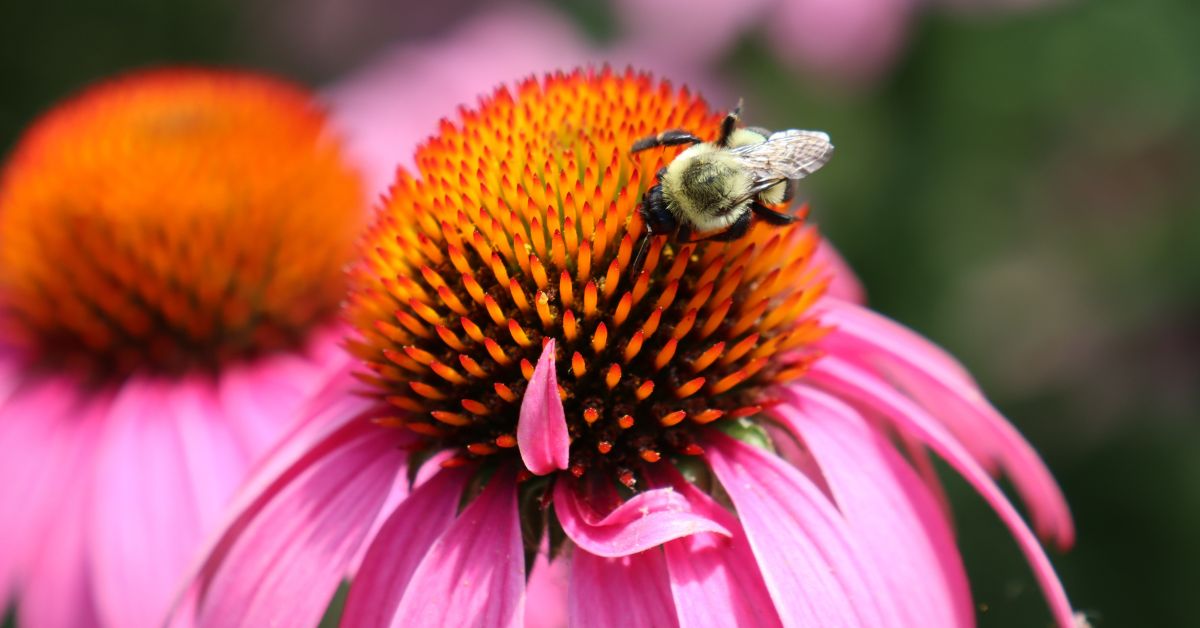Author: Lisa Trapp
Perhaps one of the most iconic and identifiable of all the native bees, bumble bees (Bombus spp.) are not only easy to recognize and universally beloved, they are also incredibly valuable pollinators. Approximately 263 different bumble bee species can be found world wide with roughly 28 different species found in the eastern half of North America. Their larger body mass can make them easy to spot, and their typically fuzzy abdomen sets them apart from wood loving carpenter bees (Xylocopa spp.).

With longer tongues and large pollen baskets on their hind legs, bumble bees are extremely effective pollinators. Their large size allows them to pry open flowers with hard-to-reach nectar, such as white turtlehead (Chelone glabra), accessing food resources that many smaller bees can’t get to. They also demonstrate a specialized form of pollination, called sonication — or “buzz pollination”. Through rapid muscle contractions in their body and wings they can create a quick and sharp “buzz” that helps knock pollen free of the flower. Several of our local crops rely on sonication in order to be effectively pollinated, including members of the nightshade family, such as tomatoes and eggplant as well as much loved fruits like blueberries, cranberries, and apples. Bumble bees can also utilize sonication to help keep them warm in cooler climates, as a result, these fuzzy friends can be found farther north than other native bees. There is even a species of bumble bee found in the northern reaches of Alaska! Bumble bees also exhibit what is known as floral constancy, which means as they forage from plant to plant they will focus on the same species, which makes them highly effective at distributing pollen from one plant to another which aids in proper fertilization. Needless to say these not so little pollinators really pull their weight!
Similar to the European honey bee (Apis mellifera), bumble bees generally live in social communities. Honey bee colonies can grow over the course of several years, but by contrast, most social bumble bees have an annual life cycle, where colonies die off in the late fall. New hive creation in the spring depends completely on future queens surviving winter hibernation. In the late summer and fall, fertilized females called gynes, or queens, will spend about two weeks foraging and increasing their fat stores. From there the queen will seek out a good place to over winter, traditionally this is in an abandoned rodent hole or below an inch of soil and leaf litter. When the soil warms and food is available again, the gyne emerges from her sleep and seeks out a good place to lay her eggs. Unlike most other bees which will nest in trees or below ground, bumble bees nest at ground level, typically in areas with heavily decaying wood. Once a good nest site is found the gyne will begin to lay eggs, all of which will be female. Her female offspring will help with raising future female workers, and hives will be created anywhere from 40 – 500 in size!
Later in the season gynes will lay unfertilized eggs which will pupate into males. Males only serve to pass along their genetics and do not contribute to finding food or tending the hive. When males leave the hive, they do not return. In mid to late summer gynes will also lay specialized female eggs which will become future gynes, and the next year’s bumble bee queens are made.
Despite the love and appreciation for the bumble bee, over 25% of North American bumble bees are experiencing some risk of extinction. Loss of habitat, loss of food resources, and changing temperatures are only a few of the pressures being placed on our native bee populations. In order to try and support these vivacious pollinators, Capital Trees does not use any systemic herbicides or pesticides in our gardens. We also leave leaf litter down from fall through spring until temperatures in the garden are above 50 degrees in hopes that future queens will have a chance to over winter successfully.
We love trying to spot as many different species as we can, so if you are in the gardens and snap a great picture of a bumble bee send it our way!
Resources:
https://beelab.umn.edu/create-nesting-habitat
BEES: An identification and Native Plant foraging Guide, Heather Holm
https://www.bumblebeeconservation.org/
https://www.bumblebeewatch.org/
https://www.fs.fed.us/wildflowers/pollinators/pollinator-of-the-month/bombus_polaris.shtml


